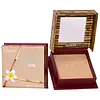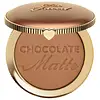What's inside
What's inside
 Key Ingredients
Key Ingredients

 Benefits
Benefits

 Concerns
Concerns

 Ingredients Side-by-side
Ingredients Side-by-side

Synthetic Fluorphlogopite
Mica
Cosmetic ColorantCI 77220
Cosmetic ColorantLauroyl Lysine
Skin ConditioningZinc Stearate
Cosmetic ColorantBoron Nitride
AbsorbentCaprylic/Capric Triglyceride
MaskingSilica
AbrasiveOryza Sativa Bran Wax
Skin ConditioningBis-Diglyceryl Polyacyladipate-2
EmollientEthylhexylglycerin
Skin ConditioningSodium Dehydroacetate
PreservativePassiflora Edulis Seed Oil
EmollientTocopherol
AntioxidantHelianthus Annuus Seed Oil
EmollientCI 77491
Cosmetic ColorantCI 77492
Cosmetic ColorantCI 77499
Cosmetic ColorantCI 77891
Cosmetic ColorantCI 15850
Cosmetic ColorantCI 77007
Cosmetic ColorantCI 19140
Cosmetic ColorantCI 42090
Cosmetic ColorantCI 77742
Cosmetic ColorantSynthetic Fluorphlogopite, Mica, CI 77220, Lauroyl Lysine, Zinc Stearate, Boron Nitride, Caprylic/Capric Triglyceride, Silica, Oryza Sativa Bran Wax, Bis-Diglyceryl Polyacyladipate-2, Ethylhexylglycerin, Sodium Dehydroacetate, Passiflora Edulis Seed Oil, Tocopherol, Helianthus Annuus Seed Oil, CI 77491, CI 77492, CI 77499, CI 77891, CI 15850, CI 77007, CI 19140, CI 42090, CI 77742
Talc
AbrasiveMica
Cosmetic ColorantTitanium Dioxide
Cosmetic ColorantOctyldodecyl Stearoyl Stearate
EmollientEthylhexyl Palmitate
EmollientBoron Nitride
AbsorbentZinc Stearate
Cosmetic ColorantSodium Saccharin
MaskingParfum
MaskingSilica
AbrasiveSodium Dehydroacetate
PreservativePhenoxyethanol
PreservativeBenzyl Benzoate
AntimicrobialTocopherol
AntioxidantAscorbyl Palmitate
AntioxidantTheobroma Cacao Fruit Powder
Skin ConditioningBenzyl Alcohol
PerfumingCI 77491
Cosmetic ColorantCI 77492
Cosmetic ColorantCI 77499
Cosmetic ColorantCI 77742
Cosmetic ColorantTalc, Mica, Titanium Dioxide, Octyldodecyl Stearoyl Stearate, Ethylhexyl Palmitate, Boron Nitride, Zinc Stearate, Sodium Saccharin, Parfum, Silica, Sodium Dehydroacetate, Phenoxyethanol, Benzyl Benzoate, Tocopherol, Ascorbyl Palmitate, Theobroma Cacao Fruit Powder, Benzyl Alcohol, CI 77491, CI 77492, CI 77499, CI 77742
 Reviews
Reviews

Ingredients Explained
These ingredients are found in both products.
Ingredients higher up in an ingredient list are typically present in a larger amount.
Boron Nitride is compound consisting of boron and nitrogen. It is used to absorb oil and modify adherence/ slip in products.
This means it is often used in makeup products to help them last longer.
Ci 77491 is also hydrated iron III oxide. It's sole purpose is to give a red/pink hue to products.
Iron III oxides are classified as inorganic chemicals for coloring.
Synthetically created Ci 77491 is considered safer than those naturally found. This is because the synthetically created version may contain less impurities. Iron oxides are generally non-toxic and non-allergenic.
Learn more about CI 77491Ci 77492 is also hydrated iron III oxide. It's sole purpose is to give a yellow hue to products.
Iron III oxides are classified as inorganic chemicals for coloring.
Synthetically created Ci 77492 is considered safer than those naturally found. This is because the synthetically created version may contain less impurities. Iron oxides are generally non-toxic and non-allergenic.
Learn more about CI 77492Ci 77499 is also hydrated iron III oxide. It is created from mixing red and black iron oxides. This helps give shades of darkness to a product.
Iron III oxides are classified as inorganic chemicals for coloring.
This ingredient is used to add a violet color to cosmetics.
It is created by reacting phosphoric acid, ammonium dihydrogen orthophosphate, and manganese dioxide.
Mica is a naturally occurring mineral used to add shimmer and color in cosmetics. It can also help improve the texture of a product or give it an opaque, white/silver color.
Serecite is the name for very fine but ragged grains of mica.
This ingredient is often coated with metal oxides like titanium dioxide. Trace amounts of heavy metals may be found in mica, but these metals are not harmful in our personal products.
Mica has been used since prehistoric times throughout the world. Ancient Egyptian, Indian, Greek, Roman, Aztec, and Chinese civilizations have used mica.
Learn more about MicaSilica, also known as silicon dioxide, is a naturally occurring mineral. It is used as a fine, spherical, and porous powder in cosmetics.
Though it has exfoliant properties, the function of silica varies depending on the product.
The unique structure of silica enhances the spreadability and adds smoothness, making it a great texture enhancer.
It is also used as an active carrier, emulsifier, and mattifier due to its ability to absorb excess oil.
In some products, tiny microneedles called spicules are made from silica or hydrolyzed sponge. When you rub them in, they lightly polish away dead skin layers and enhance the penetration of active ingredients.
Learn more about SilicaThis ingredient is a preservative with antimicrobial properties. It is the sodium salt of dehydroacetic acid.
It is especially effective at preventing bacterial and fungal growth in low concentrations.
Tocopherol (also known as Vitamin E) is a common antioxidant used to help protect the skin from free-radicals and strengthen the skin barrier. It's also fat soluble - this means our skin is great at absorbing it.
Vitamin E also helps keep your natural skin lipids healthy. Your lipid skin barrier naturally consists of lipids, ceramides, and fatty acids. Vitamin E offers extra protection for your skin’s lipid barrier, keeping your skin healthy and nourished.
Another benefit is a bit of UV protection. Vitamin E helps reduce the damage caused by UVB rays. (It should not replace your sunscreen). Combining it with Vitamin C can decrease sunburned cells and hyperpigmentation after UV exposure.
You might have noticed Vitamin E + C often paired together. This is because it is great at stabilizing Vitamin C. Using the two together helps increase the effectiveness of both ingredients.
There are often claims that Vitamin E can reduce/prevent scarring, but these claims haven't been confirmed by scientific research.
Learn more about TocopherolZinc Stearate is the metal salt of stearic acid. It is a white solid used to bind, thicken, and lubricate products.
This ingredient is common in powder makeup, where it helps keep the powder together.
Zinc Stearate is hydrophobic and repels water.
This ingredient can be sourced from non-animal or animal sources. It is best to reach out to the brand to see where they source this ingredient from.
Learn more about Zinc Stearate